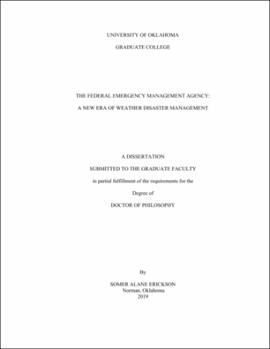| dc.description.abstract | Weather directly accounts for nearly all Major Disaster Declarations nationwide and plays a critical role in FEMA decision making. However, the decision making process among FEMA, and emergency management in general, is not substantially embedded within existing literature. Despite the importance of weather information and continued increase in vulnerabilities due to climate change, population migration, etc., the decision making process in relation to weather events is not well understood. This study examines FEMA utilization and communication of weather information for maintaining situational awareness in support of decision making. The culmination of this work advances the profession and discipline of emergency management by providing a sound methodology and decision making process framework for FEMA, in relation to weather information. The utilization of which is applicable for FEMA beyond the scope of this study and can be extended analogously to be inclusive of all hazard types. The implications of this work are to enhance FEMA leadership weather decision making capabilities in support of more timely, relevant decisions and more effective, efficient operations to enhance their ability to mitigate, prepare for, respond to, and recover from disasters leading to saved lives and property.
The purpose of this research is to bridge the gap between meteorological needs and existing educational and informational structures, requirements, and impediments to enhance decision making, situational awareness, and communication within FEMA. The major overarching questions this research seeks to answer are: (1) How is weather information utilized and communicated within FEMA?, (2) What are the primary elements and influencers of FEMA leadership decision making regarding weather?, and (3) How can FEMA best prepare for disaster operations for weather events? Utilizing an exploratory case study design, based on the Baumgart et al. (2008) model of local emergency management severe weather decision making (comprised of three systems: (1) environmental, (2) informational, and (3) perceptual and cognitive) in conjunction with the Endsley (1995) model of situation awareness (comprised of three levels: (1) perception, (2) comprehension, and (3) projection), data analysis of qualitative surveys and interviews yielded several findings.
First and foremost, (1) operational decision making at FEMA is heavily influenced by a multitude of factors including (a) organizational, (b) operational, (c) individual, (d) informational, (e) impact, and (f) hazard. Further complicating matters, FEMA utilizes a variety of information sources and communication mechanisms including media/social media, State/Tribe/Territory, private sector/ apps, television/radio, internet/web, Emergency Support Functions/partners, National Weather Service, and other agencies, yet (2) a communication gap exists between FEMA and the public. Furthermore, (3) utilization of weather information across FEMA is substantive for the purposes of (a) situational awareness, (b) analysis and assessment, (c) communication, (d) planning, (e) disaster assistance, and (f) overall decision making. (4) Maintaining situational awareness of weather hazards is an essential and mission critical FEMA function requiring (a) environmental information (weather and non-weather information), (b) impact information, and (c) communication elements, through an information management process of (a) monitoring, (b) collecting, (c) interpreting, (d) analyzing, and (e) disseminating. However, (5) FEMA personnel lack weather experience, knowledge and training overall, posing significant challenges.
These findings resulted in (1) a proposed decision making conceptual framework, in conjunction with a (2) descriptive decision making model, and (3) identification of associated influencers. Extending this work beyond theoretical notions into praxis, (4) an adaptation of the CDC’s Crisis and Emergency Risk Communication (CERC) model is proposed for FEMA utilization, and (5) operationalization of a FEMA weather training module for situational awareness was designed and implemented. Additional recommendations from these findings and results include: (1) development of weather driven FEMA decision/support policy for standardized coordination, (2) implementation of CERC principles within FEMA and emergency management for enhanced and continuous communication practices, (3) incorporation of evaluation into the Comprehensive Emergency Management (CEM) framework as a standalone element in accordance with CERC, and subsequent incorporation of evaluation findings consistently within FEMA for advancement of programs and procedures, (4) enhanced decision support and development of State and FEMA Region weather products, graphics, and overviews, etc. for improved situational awareness, and lastly, (5) inclusion of weather training requirements within FEMA qualifications for increased knowledge and awareness in support of more effective decision making and operations. | en_US |
